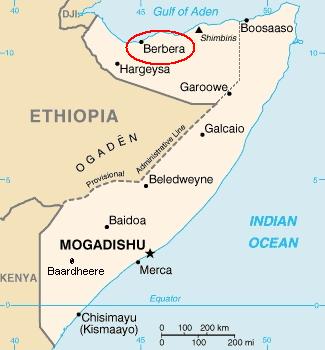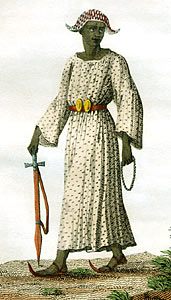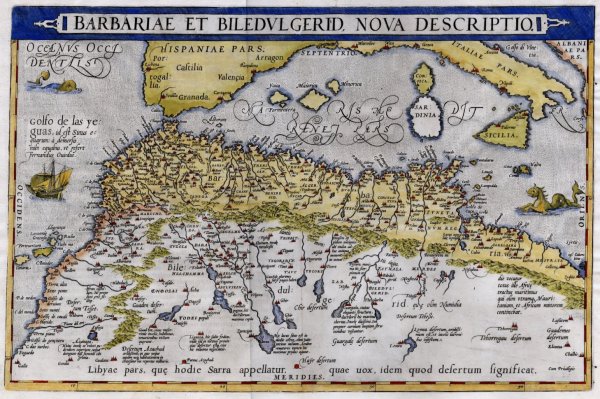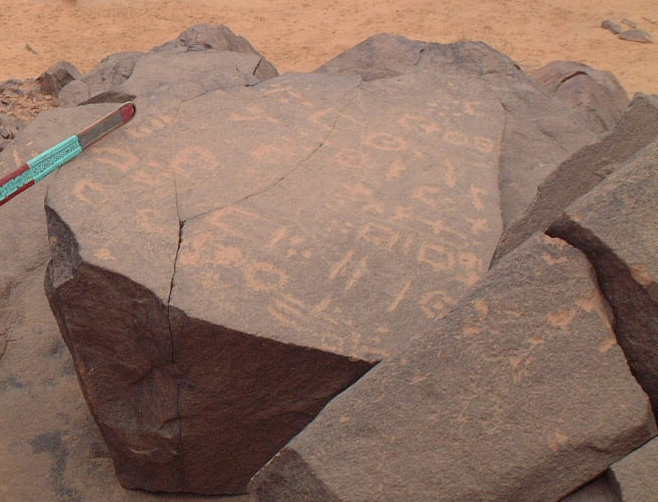Berbers
Etymology
The name "Berber" derives from variants of the root "barbar," which exist in most Indo-European sub-languages and Arabic. The Greek word "Βαρβαρος" (or the English transliteration, "barbaros") was initially used to refer to non-native speakers (also as non-citizens) in a manner quite similar to the definition of the Sanskrit word "barbara," which also means stammering.
Greek writers, Isocrates (436 - 338 BC) and Xenophon (430 - 354 BC) frequently used "barbaros" when referring to Persians (and other Asians), and the ancient Romans used the word "barbarus" (feminine: barbara) to refer to foreigners, such as Huns, Gauls, and Africans. The Romans expanded its definition to a more negative connotation (e.g. savage and uncivilized), and from the Roman use of the word, we get our present use of "barbarian" in modern English, as well as variants in other European languages.
However, neither ancient Greek nor Roman writers used the term to specifically refer to northwest Africa (Greeks commonly called this area "Libya" and to Romans, it was Mauretania).
The term "Berber," as it relates to Africans, was first used by medieval Arabic-speaking Muslim writers (from the Arabic word, "al-barbar") in a similar manner to the original meaning of barbar--to refer to speakers of foreign languages. Arabic-speaking Muslim writers did not use it to refer to any particular African region, culture, or ethnicity. Instead, the term referred to non-Arabic speaking Muslims who were also indigenous Africans (i.e., "black"). It was not until much later in history that Europeans began calling the northwest African coast, "Barbary," and even later before they began referring to certain northwest Africans as Berbers.
History of the So-called "Berbers"
 |
In Mogadishu, Battuta noted,
Battuta also referred to the non-Arabic speaking Muslim leaders as Berbers while in Takadda, a city in Eastern Mali:
 |
 |
It was actually Europeans who made the modern term "Berber" synonymous with Northwest Africans. The practice originates in the late 1400s AD, when Sevillian historians such as Antonio de Nebrija (1441-1522) vowed to return Andalusia from the "barbaric state" (i.e., "Barbaria") or the absence of Latin-based study due to the previous invasions from Northwest Africa. Nebrija once stated,
Just as Nebrija suggested attacking "Barbaria herself," Spain went on the offensive in 1501, and by 1509 it captured Oran, a city on the modern-day Algerian coast. Thereafter, variations of "Barbaria" in specific reference to the Northwest African coast suddenly appeared in literature and on maps throughout Western Europe (Biledulgerid referred to the inland region of North Africa). One of the earliest examples was in Flemish cartographer, Abraham Ortelius' map of "Barbariae" which denoted the Northwest African coast including present day Morocco, and the northernmost portions of Algeria, Tunisia and Libya. From that point until (and perhaps after) the 19th century AD, European cartographers largely used variants of "Barbaria," such as the Anglicized "Barbary Coast" or "Barbary States" to refer to this particular region (as well as the Ottoman corsaires or Turkish pirates who operated the port cities), which is precisely when it was completely under the control of the Ottoman Empire (starting with Emperors Selim I and Suleiman the Magnificent).
The French derivative of "Barbariae" was used on world maps after they took control over Northwest Africa in 1830 AD. They called the region "Berbérie" and eventually, they distinguished the Turkish and Arabic speaking people who mainly lived along the coasts from the Tamazight speaking people who mainly lived inland whom the French began calling "Berbères." This quickly led to the broader use of "Berber" to refer to all Tamazight speakers of inland Northwest Africa. In the 1830s, English historians began referring to these people and their language as Berber, and English dictionaires began defining Berber accordingly. In The Imperial Dictionary of the English Language by John Olgive (1885), it was defined as "a person belonging to a group of tribes inhabiting the mountainous parts of Barbary and portions of the Sahara; the language spoken by the Berbers, and having affinities with the Semitic languages."
 |
Although many Westerners mistakenly believe that all so-called "Berbers" are light-skinned people with stereotypical European facial features, a simple examination of the history of the Amajegh (Tuareg) people, most of whom are dark-skinned, would easily refute such notions.
Even by the 19th century, Europeans who had personally encountered so-called Berbers thoroughly described their dark skin and stereotypical African features:
- James Crowles Prichard (1837)
"The color of the population of Tuggurt [capital of Wadreag] is black, and they are called Erwagha."
"Ghadames [in present-day western Libya] is a large town...the inhabitants speak the Berber language...Their complexion is black..."
- W.B. Hodgson (1831)
